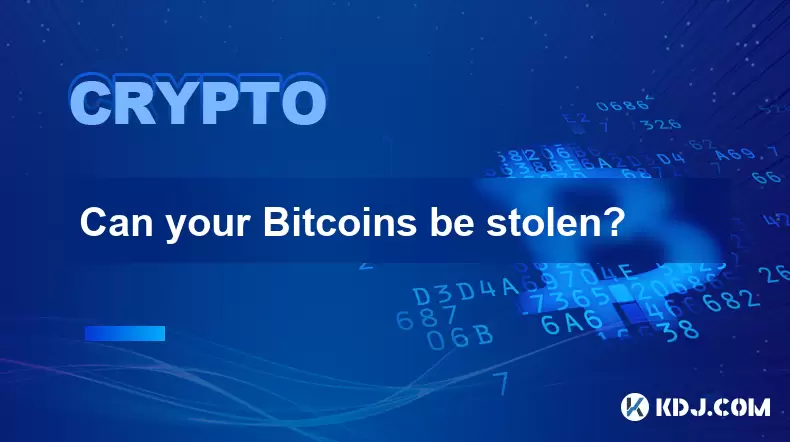-
 Bitcoin
Bitcoin $115100
1.27% -
 Ethereum
Ethereum $3675
2.71% -
 XRP
XRP $2.995
1.45% -
 Tether USDt
Tether USDt $1.000
0.02% -
 BNB
BNB $769.8
2.64% -
 Solana
Solana $168.0
3.25% -
 USDC
USDC $0.9999
-0.01% -
 TRON
TRON $0.3371
1.48% -
 Dogecoin
Dogecoin $0.2051
3.36% -
 Cardano
Cardano $0.7394
2.30% -
 Hyperliquid
Hyperliquid $38.15
0.42% -
 Stellar
Stellar $0.3966
-0.36% -
 Sui
Sui $3.486
2.93% -
 Chainlink
Chainlink $16.72
2.52% -
 Bitcoin Cash
Bitcoin Cash $568.0
4.36% -
 Hedera
Hedera $0.2440
2.59% -
 Ethena USDe
Ethena USDe $1.001
0.04% -
 Avalanche
Avalanche $22.16
2.06% -
 Litecoin
Litecoin $119.1
-0.73% -
 UNUS SED LEO
UNUS SED LEO $8.991
0.04% -
 Toncoin
Toncoin $3.232
-0.39% -
 Shiba Inu
Shiba Inu $0.00001233
2.82% -
 Uniswap
Uniswap $9.717
2.53% -
 Polkadot
Polkadot $3.664
1.85% -
 Dai
Dai $1.000
0.01% -
 Monero
Monero $281.2
-3.89% -
 Bitget Token
Bitget Token $4.350
1.55% -
 Cronos
Cronos $0.1428
5.07% -
 Pepe
Pepe $0.00001050
3.68% -
 Aave
Aave $262.3
3.54%
Can your Bitcoins be stolen?
Bitcoin’s network is secure, but your funds are only as safe as your private keys—protect them with hardware wallets and offline storage to prevent theft.
Aug 07, 2025 at 03:28 am

Understanding the Security of Bitcoin Ownership
The decentralized nature of Bitcoin means that no central authority controls the network, placing the responsibility of security directly on the user. While the Bitcoin blockchain itself is highly secure due to cryptographic hashing and consensus mechanisms like Proof of Work, the risk of theft lies primarily in how individuals manage their private keys. These keys are essential for accessing and authorizing transactions from a Bitcoin wallet. If a malicious actor gains access to your private key, they can transfer your Bitcoins to another wallet, effectively stealing them. This makes the protection of private keys the most critical aspect of Bitcoin security.
It is important to distinguish between the security of the network and the security of personal holdings. The Bitcoin protocol has never been hacked, but thousands of users have lost funds due to poor security practices. Theft typically occurs through phishing attacks, malware, or insecure storage methods. Therefore, while the network resists tampering, individual wallets are vulnerable if not properly secured.
Common Methods of Bitcoin Theft
Malicious actors use various techniques to gain unauthorized access to Bitcoin holdings. One prevalent method is phishing, where attackers impersonate legitimate services such as exchanges or wallet providers. They send fake emails or create counterfeit websites that prompt users to enter their private keys or recovery phrases. Once entered, the attacker gains full control over the wallet.
Another method involves malware designed to scan a device for wallet files or clipboard contents. Some malware monitors the clipboard for Bitcoin addresses and swaps them with the attacker’s address when a transaction is copied. This results in funds being sent to the wrong destination without the user realizing it until it’s too late.
SIM swapping is another serious threat. Attackers trick mobile carriers into transferring a victim’s phone number to a new SIM card they control. If two-factor authentication (2FA) relies on SMS, the attacker can bypass security and access accounts linked to that number, including exchange accounts holding Bitcoin.
Exchange hacks are also a source of theft. While exchanges implement security measures, centralized platforms are attractive targets. If an exchange’s hot wallet is compromised, user funds stored there may be lost. This highlights the risk of keeping large amounts of Bitcoin on third-party platforms.
Securing Your Bitcoin: Best Practices
To prevent theft, users must adopt proactive security strategies. The most effective approach is using a hardware wallet, which stores private keys offline. These devices only connect to a computer when signing transactions, making them immune to online attacks. Popular options include Ledger and Trezor.
When setting up a hardware wallet, follow these steps:
- Purchase the device directly from the manufacturer to avoid tampered units.
- Initialize the device in a secure environment.
- Write down the recovery seed phrase on paper and store it in a fireproof, waterproof safe.
- Never share the seed phrase with anyone, and never store it digitally.
- Enable the device’s PIN protection.
For additional security, consider using a passphrase (also known as a 25th word) in addition to the standard 12- or 24-word seed. This creates a hidden wallet that cannot be accessed even if the seed is compromised, as long as the passphrase remains secret.
Avoid using web-based or mobile wallets for long-term storage. These are convenient but more exposed to malware and phishing. If you must use them, ensure the device is dedicated, updated, and free of suspicious apps.
Recovering Stolen Bitcoin: Is It Possible?
Once Bitcoin is transferred to another wallet, reversing the transaction is impossible due to the immutable nature of the blockchain. Unlike traditional banking systems, there is no central authority to freeze funds or reverse payments. This permanence is a core feature of Bitcoin but also a major challenge in theft cases.
However, there are limited avenues for recovery. If the stolen funds pass through a regulated exchange, law enforcement may be able to trace the flow and freeze assets. Blockchain analysis firms like Chainalysis can track transaction paths and identify wallets linked to known services. Success depends on the thief’s operational security and whether they attempt to cash out through a KYC-compliant platform.
In some cases, victims have negotiated with attackers for the return of funds, often in exchange for a ransom or promise of non-disclosure. These situations are rare and not recommended, as they encourage further criminal behavior.
Reporting the theft to relevant authorities is crucial. Provide transaction IDs, wallet addresses, and any evidence of phishing or malware. While recovery is unlikely, documentation helps build patterns that may assist in broader investigations.
Protecting Against Future Threats
Staying informed about emerging threats is essential. Cybercriminals continuously evolve their tactics, so users must update their knowledge and tools. Regularly check for firmware updates on hardware wallets and apply them promptly. Enable multi-signature setups for high-value wallets, which require multiple keys to authorize a transaction, adding an extra layer of security.
Use air-gapped systems for signing transactions when possible. This involves a computer that never connects to the internet, reducing exposure to remote attacks. Combine this with a hardware wallet for maximum protection.
Avoid public Wi-Fi when accessing wallet interfaces. Use a trusted, encrypted connection and consider a virtual private network (VPN) for added privacy. Never click on unsolicited links or download attachments from unknown sources.
Keep backups of your seed phrase in multiple secure locations, but never online. Consider using metal seed phrase backups that resist physical damage. Test your recovery process in a safe environment to ensure you can restore access if needed.
Frequently Asked Questions
Can someone steal my Bitcoin just by knowing my wallet address?
No. A Bitcoin wallet address is public and can be shared freely. Theft requires access to the private key or recovery phrase, not the address itself.
What should I do if I accidentally send Bitcoin to the wrong address?
Transactions cannot be reversed. If you sent funds to an incorrect address, contact the recipient if known. Otherwise, the loss is permanent.
Are cold wallets completely safe from theft?
Cold wallets are highly secure but not immune. Physical theft, loss of the device, or compromise of the seed phrase can still result in loss. Always protect the physical device and backup.
How can I verify a hardware wallet is authentic?
Buy directly from the official website. Check packaging for tamper-evident seals. Verify the device’s authenticity using the manufacturer’s verification tool during setup.
Disclaimer:info@kdj.com
The information provided is not trading advice. kdj.com does not assume any responsibility for any investments made based on the information provided in this article. Cryptocurrencies are highly volatile and it is highly recommended that you invest with caution after thorough research!
If you believe that the content used on this website infringes your copyright, please contact us immediately (info@kdj.com) and we will delete it promptly.
- BlockDAG, Litecoin, and Cardano: Charting the Course in Crypto's Dynamic Waters
- 2025-08-07 09:09:06
- Fireverse Token: Igniting a Musical Revolution in Web3
- 2025-08-07 08:27:45
- Ethereum, L2 Withdrawals, and Decentralization: A New Yorker's Take
- 2025-08-07 08:32:33
- Avalanche vs. Ruvi AI: Daily Sales Tell a Story of Crypto Disruption
- 2025-08-07 06:29:35
- DeSoc: The Crypto to Buy Now for a Decentralized Future (and Maybe 43x Gains!)
- 2025-08-07 06:50:16
- Arctic Pablo Coin: Riding the Meme Coin Wave with a Deflationary Twist
- 2025-08-07 07:18:13
Related knowledge

Do you need to understand technology to use Bitcoin?
Aug 07,2025 at 06:17am
Understanding the Basics of BitcoinTo engage with Bitcoin, one does not need a deep understanding of the underlying technology, much like how individu...

Can your Bitcoins be stolen?
Aug 07,2025 at 03:28am
Understanding the Security of Bitcoin OwnershipThe decentralized nature of Bitcoin means that no central authority controls the network, placing the r...

How does Bitcoin compare to gold?
Aug 07,2025 at 03:18am
Historical Context and Origins of Bitcoin and GoldUnderstanding the comparison between Bitcoin and gold begins with their origins and historical roles...

Can you lose money with Bitcoin?
Aug 07,2025 at 07:49am
Understanding the Volatility of BitcoinBitcoin is known for its extreme price volatility, which is one of the primary reasons investors can lose money...

How does Bitcoin function as a digital currency?
Aug 07,2025 at 02:50am
Understanding Bitcoin as a Digital CurrencyBitcoin operates as a decentralized digital currency, meaning it functions without a central authority such...

What is Bitcoin and how does it work?
Aug 07,2025 at 03:42am
What is Bitcoin?Bitcoin is a decentralized digital currency that operates without the need for a central authority or intermediary. Created in 2009 by...

Do you need to understand technology to use Bitcoin?
Aug 07,2025 at 06:17am
Understanding the Basics of BitcoinTo engage with Bitcoin, one does not need a deep understanding of the underlying technology, much like how individu...

Can your Bitcoins be stolen?
Aug 07,2025 at 03:28am
Understanding the Security of Bitcoin OwnershipThe decentralized nature of Bitcoin means that no central authority controls the network, placing the r...

How does Bitcoin compare to gold?
Aug 07,2025 at 03:18am
Historical Context and Origins of Bitcoin and GoldUnderstanding the comparison between Bitcoin and gold begins with their origins and historical roles...

Can you lose money with Bitcoin?
Aug 07,2025 at 07:49am
Understanding the Volatility of BitcoinBitcoin is known for its extreme price volatility, which is one of the primary reasons investors can lose money...

How does Bitcoin function as a digital currency?
Aug 07,2025 at 02:50am
Understanding Bitcoin as a Digital CurrencyBitcoin operates as a decentralized digital currency, meaning it functions without a central authority such...

What is Bitcoin and how does it work?
Aug 07,2025 at 03:42am
What is Bitcoin?Bitcoin is a decentralized digital currency that operates without the need for a central authority or intermediary. Created in 2009 by...
See all articles

























































































